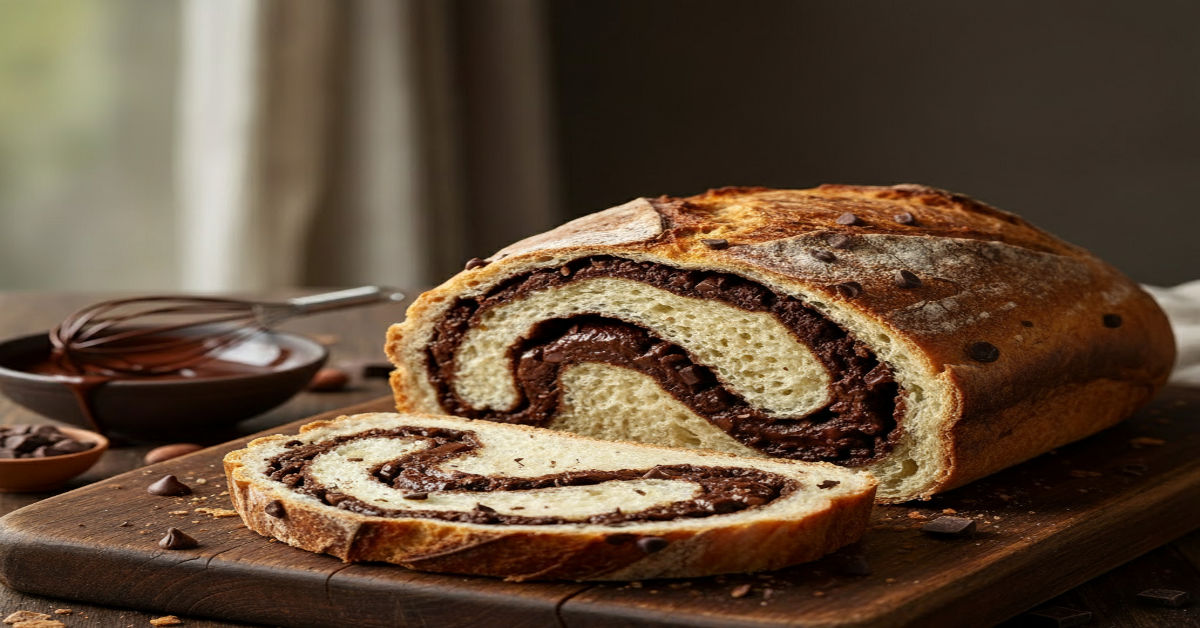A loaf with a chocolate swirl enchants from the moment you lay eyes on it. The dark ribbons of chocolate twisting into the golden crumb look like edible art. Each slice reveals a unique pattern—a promise of comfort and decadence rolled into one. This loaf invites more than hunger; it invites curiosity and delight.
Beyond aesthetics, the appeal lies in its harmonious contrast. The soft pillowy dough embraces the richness of chocolate but never lets it dominate. With every bite, you discern structure and sweetness, warmth and depth. It’s a loaf that feels familiar yet feels luxurious perfect for everyday breakfasts or special treats.
What Defines a True Chocolate-Swirl Loaf
Not every bread with chocolate qualifies. A genuine chocolate swirl loaf has certain qualities: the swirl must be internal (not merely a spread or topping), distinct but well integrated, and the crumb must hold together without collapse. The chocolate should remain in strands or pockets rather than bleeding into mushy zones.
Texture matters as much as pattern. Good swirl loaves manage a balance—airy enough to be soft, robust enough not to tear, and rich enough to deliver chocolate without overwhelming dryness. The swirl should be visible but not rigid, giving a marbled effect that remains soft. When you toast a slice, the chocolate should melt gently not drip uncontrollably or harden into shards.
A loaf that lacks definition or where chocolate bleeds is often a sign of technical misstep. The ideal loaf carries its swirl with grace.
Origins and Cultural Journey
The concept of bread with swirled fillings likely traces its roots to Eastern Europe, where enriched breads filled with cinnamon, nuts, or chocolate features are a time-honored tradition. The babka, in particular, is one ancestor to our modern chocolate swirl loaf. Over countless environments and tastes, bakers adapted, refined, and made new versions.
As chocolate became more accessible in Europe in the 18th and 19th centuries, it found its way into sweet breads. The swirl method allowed filling to infuse dough without simply soaking it. Over time, classic techniques traveled via migration and exchange, influencing bakery traditions in the Middle East, Americas, and Asia. Now, chocolate-swirl loaves appear in cafés and home kitchens globally.
Today’s bakers bring innovations—ethnic flavors, twists on texture, and modern ingredients—while paying homage to lineage. The swirl itself is a bridge between tradition and creativity.
Key Ingredients and Their Roles
To bake a stellar loaf with a chocolate swirl, every ingredient must be chosen with purpose. Below is a table summarizing critical components, why they matter, and tips for optimization:
| Ingredient | Purpose in the Loaf | Best Selection | Enhancement Tips |
| Bread flour / strong all-purpose | Builds gluten network to support swirl | 12–14% protein flour | Autolyze 10–15 mins before kneading |
| Yeast (instant or active dry) | Leavening and rise | Quality fresh yeast | Verify with proofing test |
| Milk or water | Hydration, softness | Whole milk or milk blend | Warm (≈ 35–40 °C) liquid for yeast |
| Butter (or fat) | Tenderness, flavor | Unsalted, high fat content | Soften before mixing |
| Sugar | Provides sweetness and feeds yeast | Fine granulated or caster | Slightly adjust fill vs dough |
| Egg(s) | Structure, color, binding | Room temperature large eggs | Use yolks if enriched profile desired |
| Cocoa or chocolate | Swirl flavor & visual contrast | High cocoa dark or blend | Melt + cool to spreadable consistency |
| Salt | Flavor balancing & gluten control | Fine sea salt | Never exceed ~2% of flour weight |
| Vanilla or extract | Aromatic layer | Pure vanilla (optional) | Add to dough or swirl layer |
Each ingredient speaks. For example, the fat (butter) coats gluten strands, giving softness. The sugar helps yeast but also caramelizes in the crust. The chocolate must be tempered in its own way—if too hot, it seeps; too cool, it won’t spread. Success lies in synergy.
When possible source single-origin cocoa or good quality couverture chocolate. The complexity of flavor will elevate the loaf above something ordinary.
The Physics and Chemistry Behind the Swirl
Baking a loaf with a chocolate swirl isn’t just artistry it’s a delicate orchestration of chemistry and physics. The dough’s gluten network must stretch and hold layers without collapse. When we roll and twist, we rely on that elasticity.
During baking, gas expansion (from CO₂) pushes the layers apart—this is the oven spring. The swirl segments expand with the dough but resist merging thanks to differential viscosity. The chocolate layer acts as a barrier but also melts into microstrata of fat and cocoa solids. The Maillard reaction browns surfaces, adding flavor. The internal moisture, steam, and heat gradients accentuate swirl definition.
Research into baking chemistry explains how proteins, lipids, starch, and sugars interact under heat. One detailed study describes how Maillard browning evolves and how moisture loss shapes crust and crumb (see The Chemistry of Baking).
To maintain swirl clarity, controlling temperature is key. If the oven is too hot, chocolate scorches or melts wildly; too cold and the loaf may expand erratically, smearing the pattern. Most bakers aim for ~175 °C (350 °F) with gentle steam or a water bath at the start to prolong crust formation and allow the swag of swirl to bake into place.
A Step-by-Step Baking Guide
Here’s a refined and practical process to follow. Each step contains purpose and nuance.
1. Dough Preparation
Combine flour (preferably sifted), sugar, salt, yeast. Add warm milk (or liquid) and eggs gradually, mixing until shaggy. Add softened butter in bits, developing gluten until dough is smooth and elastic.
2. Bulk Fermentation (First Rise)
Cover the dough and let it rise in a warm, draft-free place until roughly doubled. This fermentation allows flavor development and gas creation.
3. Prepare the Chocolate Filling
Melt chocolate and butter together with a little sugar, stir until smooth, then cool to a spreadable temperature. The filling should be thick but spreadable—never runny.
4. Rolling and Layering
On lightly floured surface, flatten the dough into a rectangle (e.g. 30×20 cm). Spread the cooled chocolate layer evenly, leaving a thin border.
5. Shaping the Swirl
Roll dough tightly into a log, pinch the seam. Use a sharp knife to slice the log along its length into two halves. Twist the halves together with cut edges exposed—this yields the swirl effect.
6. Final Proofing
Place the twisted loaf in a greased loaf pan or on parchment. Cover and allow a second rise until nearly full (often 45–60 minutes).
7. Baking
Preheat your oven to around 175 °C (350 °F). Optionally, start with a burst of steam (e.g. via tray of hot water). Bake 30–40 minutes until the internal temperature reaches about 95 °C (205 °F). The crust should be golden with chocolate visible but not burnt.
8. Cooling and Slicing
Allow a full cool on wire racks before slicing. The chocolate needs time to set internally; slicing too early may blur the swirl.
This sequence ensures structure, flavor and appearance evolve in harmony.
Pitfalls to Watch Out For
Every baker faces challenges with swirl loaves. Knowing them ahead helps.
Leaky or runny chocolate
If your filling is too warm or thin, it seeps into the dough, causing collapse or marbling. Always cool to a spreadable consistency. Test on a scrap of dough before full application.
Poor swirl definition
When the dough is rolled loosely or twisted unevenly, the swirl becomes muddled. Use intentional rolling and twist evenly but gently.
Dense crumb or collapse
Too much weight in filling or under-kneaded dough weakens structure. Also overproofing may collapse the structure. Ensure proper gluten formation and monitor proving time.
Burning or dry crust
Overbaking or high heat scorches the top before interior sets. Add foil later or bake at moderate heat.
A handy reference is below:
| Problem | Likely Cause | Fix |
| Filling bleeds | Too warm, too thin | Cool filling or thicken with extra cocoa |
| Swirl blurred | Loose shaping | Roll tightly, twist carefully |
| Heavy loaf | Too much filling | Reduce fill ratio or lighten dough |
| Crust too dark | High oven heat | Lower temp, cover, check earlier |
Addressing these issues will greatly raise success rate.
Creative Variations to Explore
Once the basic loaf is mastered, crafting variations becomes a playground.
Nut-studded swirl
Add finely chopped hazelnuts, almonds, or walnut pieces into the chocolate layer before rolling. This adds crunch and complexity.
Citrus-chocolate swirl
Mix a teaspoon or two of orange or lemon zest into your chocolate filling. The bright citrus oils uplift richness beautifully.
Espresso chocolate swirl
Incorporate a small dose of espresso powder or instant coffee into the chocolate. The deep roast notes complement cocoa elegantly.
White chocolate swirl
Replace dark with tempered white chocolate or a white chocolate ganache swirl. The contrast is striking visually.
Vegan / dairy-free version
Use plant milks, vegan butter or coconut oil, and dairy-free chocolate. Binders like flax eggs or aquafaba can support dough structure.
Here’s a comparison table for variation ideas:
| Variation | Add-in or Change | Effect on Flavor & Texture | Use Case |
| Nutty swirl | Chopped nuts | Adds crunch, nutty tones | Holiday loaves |
| Citrus swirl | Zest or citrus oil | Bright acidity cuts richness | Spring or brunch |
| Mocha swirl | Espresso + cocoa | Deep, complex flavor | Coffee companion |
| White swirl | White chocolate | Creamy, sweeter contrast | Elegant dessert loaf |
| Vegan swirl | Vegan substitutes | Slightly lighter texture | Dietary restriction |
These variations encourage creativity without losing the essence of the swirl loaf.
Nutrition, Indulgence and Balance
Even an indulgent loaf can be enjoyed wisely. Understanding its nutritional components helps.
A typical slice of swirl loaf (≈ 80–90 g) might contribute:
- Calories: 240–300 kcal
- Carbohydrates: 35–40 g
- Sugar: 8–12 g
- Fat: 10–14 g
- Protein: 5–7 g
- Fiber: 1–2 g
To improve nutritional balance:
- Use whole wheat or part whole wheat flour for more fiber.
- Choose dark chocolate with high cocoa and lower sugar content.
- Lower overall filling proportion, or include fruit or nut bits to add micronutrients.
- Serve in modest portions along with protein or fruit.
In moderation, a swirl loaf becomes a treat—not a burden.
Serving Ideas and Pairings
How you serve the loaf enhances the experience. Consider these scenarios:
Morning delight
Serve slightly warm with a smear of butter or ricotta. Pair with black coffee or café au lait.
Afternoon indulgence
Toast slices and top with fresh berries or mascarpone. Serve alongside tea or a mild dessert wine.
Elegant dessert
Cut thin slices, warm slightly, and serve with vanilla ice cream or crème anglaise.
Savory contrast
Top lightly toasted slices with salted butter or a sprinkle of flaky sea salt to balance sweetness.
Use presentation details—wooden boards, cloth napkins, fresh herbs or fruits—to elevate the visual appeal. Even on a simple tray, the swirl loaf becomes a centerpiece.
Storage, Slicing and Freshness Tips
Proper storage preserves both swirl integrity and flavor. Once cooled, wrap the loaf in parchment or a cotton tea towel then place in airtight containers or bread boxes for up to 2–3 days. Avoid refrigeration, which accelerates staling.
For longer storage, freeze individual slices separated by parchment. When ready to eat, toast straight from frozen to reawaken aroma and texture.
When slicing, use a serrated knife and a gentle sawing motion to avoid squashing the swirl. Let slices rest a minute before serving so the chocolate layers settle.
Final Thoughts and Invitation
A loaf with a chocolate swirl is more than a baked good—it is a canvas, a conversation, a sensory experience. From ingredients and chemistry to shaping and presentation, every step offers subtlety and possibility. The swirl symbolizes transformation—how simple wheat, fat, sugar, and cocoa can become something beautiful and moving.
I invite you to experiment—with zests, nuts, alternative flours or dietary constraints—and make your own signature swirl. When you serve that first slice, you’re offering more than flavor you share craftsmanship, warmth and creativity.
FAQs on Troubleshooting and Adaptations
Can I use cocoa powder instead of melted chocolate for the swirl?
Yes, but blend cocoa with melted butter, a touch of milk, and sugar so it becomes spreadable. Pure cocoa without fat won’t produce the right texture.
Why did my swirl vanish after baking?
Often caused by over proofing too much filling or weak dough structure. Reduce proving time or firm up your filling.
Is it possible to make this without eggs?
Yes. Use substitutes like flaxseed “egg,” yogurt, or aquafaba (in vegan versions). Adjust hydration accordingly.
What pan is best?
A standard loaf pan (e.g. 8½×4½ inches) offers even structure. Some bakers free-form on parchment for rustic shape.
Can I convert this to gluten-free?
Use a strong gluten-free bread blend plus xanthan gum or psyllium for structure. Expect a different but inspiring result.







